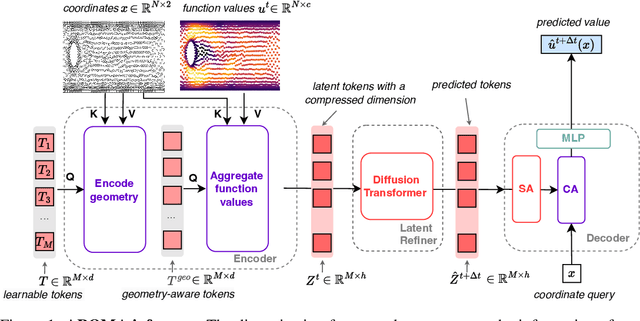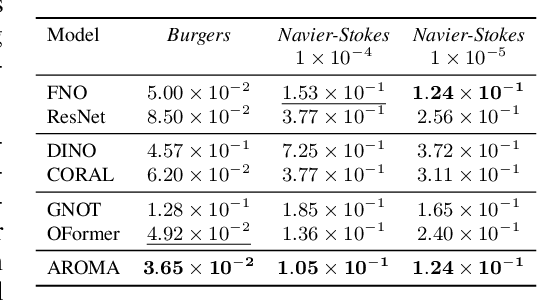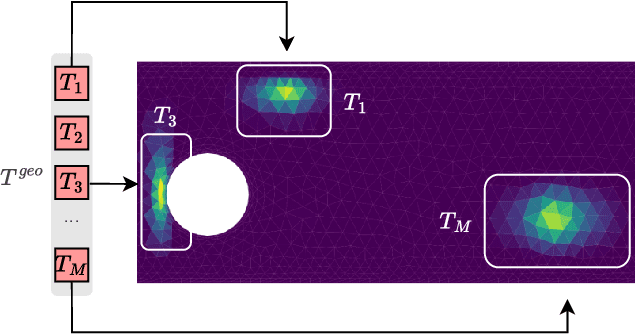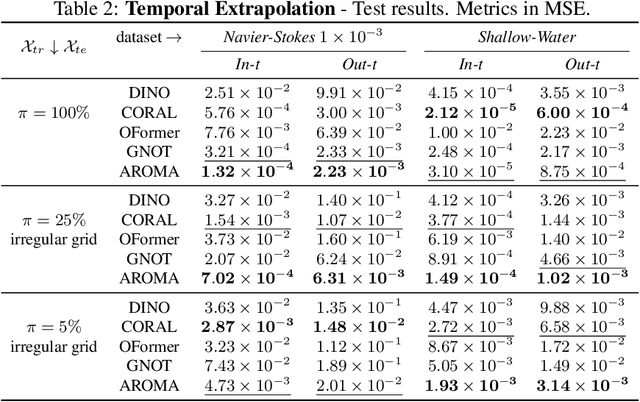Etienne Le Naour
ISIR
MoTM: Towards a Foundation Model for Time Series Imputation based on Continuous Modeling
Jul 18, 2025Abstract:Recent years have witnessed a growing interest for time series foundation models, with a strong emphasis on the forecasting task. Yet, the crucial task of out-of-domain imputation of missing values remains largely underexplored. We propose a first step to fill this gap by leveraging implicit neural representations (INRs). INRs model time series as continuous functions and naturally handle various missing data scenarios and sampling rates. While they have shown strong performance within specific distributions, they struggle under distribution shifts. To address this, we introduce MoTM (Mixture of Timeflow Models), a step toward a foundation model for time series imputation. Building on the idea that a new time series is a mixture of previously seen patterns, MoTM combines a basis of INRs, each trained independently on a distinct family of time series, with a ridge regressor that adapts to the observed context at inference. We demonstrate robust in-domain and out-of-domain generalization across diverse imputation scenarios (e.g., block and pointwise missingness, variable sampling rates), paving the way for adaptable foundation imputation models.
AROMA: Preserving Spatial Structure for Latent PDE Modeling with Local Neural Fields
Jun 04, 2024



Abstract:We present AROMA (Attentive Reduced Order Model with Attention), a framework designed to enhance the modeling of partial differential equations (PDEs) using local neural fields. Our flexible encoder-decoder architecture can obtain smooth latent representations of spatial physical fields from a variety of data types, including irregular-grid inputs and point clouds. This versatility eliminates the need for patching and allows efficient processing of diverse geometries. The sequential nature of our latent representation can be interpreted spatially and permits the use of a conditional transformer for modeling the temporal dynamics of PDEs. By employing a diffusion-based formulation, we achieve greater stability and enable longer rollouts compared to conventional MSE training. AROMA's superior performance in simulating 1D and 2D equations underscores the efficacy of our approach in capturing complex dynamical behaviors.
WindDragon: Enhancing wind power forecasting with Automated Deep Learning
Feb 22, 2024Abstract:Achieving net zero carbon emissions by 2050 requires the integration of increasing amounts of wind power into power grids. This energy source poses a challenge to system operators due to its variability and uncertainty. Therefore, accurate forecasting of wind power is critical for grid operation and system balancing. This paper presents an innovative approach to short-term (1 to 6 hour horizon) windpower forecasting at a national level. The method leverages Automated Deep Learning combined with Numerical Weather Predictions wind speed maps to accurately forecast wind power.
Interpretable time series neural representation for classification purposes
Oct 25, 2023Abstract:Deep learning has made significant advances in creating efficient representations of time series data by automatically identifying complex patterns. However, these approaches lack interpretability, as the time series is transformed into a latent vector that is not easily interpretable. On the other hand, Symbolic Aggregate approximation (SAX) methods allow the creation of symbolic representations that can be interpreted but do not capture complex patterns effectively. In this work, we propose a set of requirements for a neural representation of univariate time series to be interpretable. We propose a new unsupervised neural architecture that meets these requirements. The proposed model produces consistent, discrete, interpretable, and visualizable representations. The model is learned independently of any downstream tasks in an unsupervised setting to ensure robustness. As a demonstration of the effectiveness of the proposed model, we propose experiments on classification tasks using UCR archive datasets. The obtained results are extensively compared to other interpretable models and state-of-the-art neural representation learning models. The experiments show that the proposed model yields, on average better results than other interpretable approaches on multiple datasets. We also present qualitative experiments to asses the interpretability of the approach.
Time Series Continuous Modeling for Imputation and Forecasting with Implicit Neural Representations
Jun 12, 2023Abstract:Although widely explored, time series modeling continues to encounter significant challenges when confronted with real-world data. We propose a novel modeling approach leveraging Implicit Neural Representations (INR). This approach enables us to effectively capture the continuous aspect of time series and provides a natural solution to recurring modeling issues such as handling missing data, dealing with irregular sampling, or unaligned observations from multiple sensors. By introducing conditional modulation of INR parameters and leveraging meta-learning techniques, we address the issue of generalization to both unseen samples and time window shifts. Through extensive experimentation, our model demonstrates state-of-the-art performance in forecasting and imputation tasks, while exhibiting flexibility in handling a wide range of challenging scenarios that competing models cannot.
 Add to Chrome
Add to Chrome Add to Firefox
Add to Firefox Add to Edge
Add to Edge